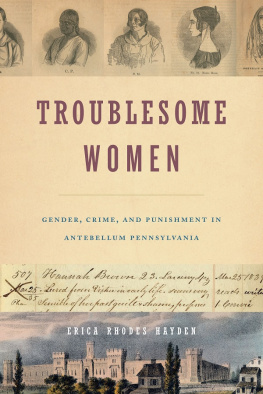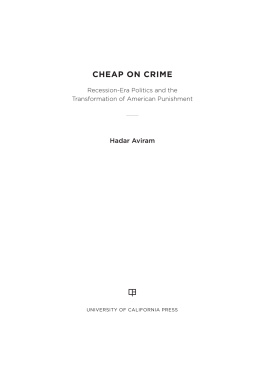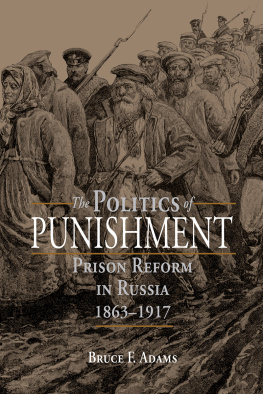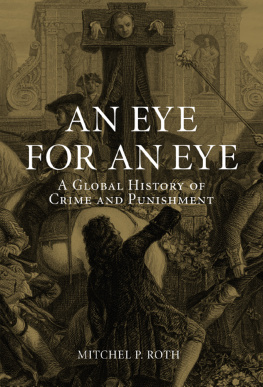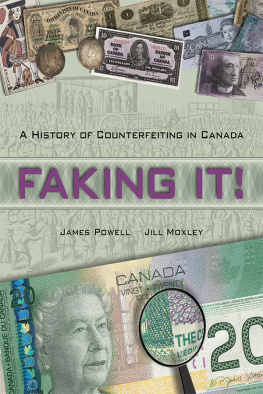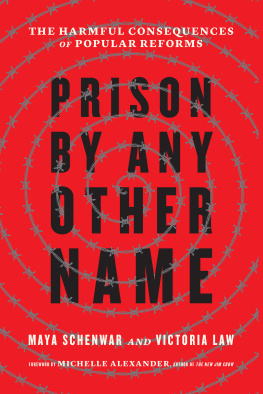McCoy - Hard Time: Reforming the Penitentiary in Nineteenth-Century Canada
Here you can read online McCoy - Hard Time: Reforming the Penitentiary in Nineteenth-Century Canada full text of the book (entire story) in english for free. Download pdf and epub, get meaning, cover and reviews about this ebook. City: Canada;Edmonton, year: 2014;2012, publisher: Athabasca University Press, genre: Politics. Description of the work, (preface) as well as reviews are available. Best literature library LitArk.com created for fans of good reading and offers a wide selection of genres:
Romance novel
Science fiction
Adventure
Detective
Science
History
Home and family
Prose
Art
Politics
Computer
Non-fiction
Religion
Business
Children
Humor
Choose a favorite category and find really read worthwhile books. Enjoy immersion in the world of imagination, feel the emotions of the characters or learn something new for yourself, make an fascinating discovery.

Hard Time: Reforming the Penitentiary in Nineteenth-Century Canada: summary, description and annotation
We offer to read an annotation, description, summary or preface (depends on what the author of the book "Hard Time: Reforming the Penitentiary in Nineteenth-Century Canada" wrote himself). If you haven't found the necessary information about the book — write in the comments, we will try to find it.
Hard Time: Reforming the Penitentiary in Nineteenth-Century Canada — read online for free the complete book (whole text) full work
Below is the text of the book, divided by pages. System saving the place of the last page read, allows you to conveniently read the book "Hard Time: Reforming the Penitentiary in Nineteenth-Century Canada" online for free, without having to search again every time where you left off. Put a bookmark, and you can go to the page where you finished reading at any time.
Font size:
Interval:
Bookmark:
Hard Time
Reforming the Penitentiary in Nineteenth-Century Canada
TED McCOY

Copyright 2012 Ted McCoy
Published by AU Press, Athabasca University
1200, 10011 109 Street, Edmonton, AB T5J 3S6
ISBN 978-1-926836-96-6 (print) 978-1-926836-97-3 ( PDF )
978-1-926836-98-0 (epub)
Cover and interior design by Marvin Harder, marvinharder.com .
Printed and bound in Canada by Marquis Book Printers.
Library and Archives Canada Cataloguing in Publication
McCoy, Ted, 1978
Hard time : reforming the penitentiary in nineteenth-century Canada / by Ted McCoy.
Includes bibliographical references and index.
Issued also in electronic formats.
ISBN 978-1-926836-96-6
1. PrisonsCanadaHistory19th century. 2. PrisonersCanadaSocial conditionsHistory19th century. 3. Prison reformersCanadaHistory19th century. 4. Convict laborCanadaHistory19th century. 5. PunishmentCanadaHistory19th century. 6. CriminalsRehabilitationCanadaHistory19th century. I. Title.
HV9960.C2M34 2012 365.7097109034 C2012-901606-3
We acknowledge the financial support of the Government of Canada through the Canada Book Fund ( CBF ) for our publishing activities.
Assistance provided by the Government of Alberta, Alberta Multimedia Development Fund.
Please contact AU Press, Athabasca University at aupress@athabascau.ca for permissions and copyright information.

I owe my thanks to a broad community who, in a variety of ways, are responsible for the existence of this book. Trent University and the Frost Centre for Canadian and Indigenous Studies offered ongoing financial and intellectual support. I am grateful as well to the Social Sciences and Humanities Research Council of Canada for additional research funding. Many friends and colleagues were invaluable sources of encouragement along the way. These include Kevin Plummer, Gillian Balfour, Julia Harrison, Winnie Janzen, Cam Hayden, Cristine Bye, Fiona Coll, Michel Hogue, Betsy Jameson, Sarah Carter, Adrian Smith, Melissa White, Sherry Hergott, and Shayne Arnold. I owe a special debt of thanks to Meaghan Beaton for her camaraderie. The enthusiastic staff at Athabasca University Press made the final steps possible, particularly Pamela Holway, who was a generous and supportive editor. Copy editor Joyce Hildebrand made numerous thoughtful suggestions that improved the final text.
Joan Sangster encouraged my first efforts to think about legal and social history and has been a trusted mentor and friend. Bryan Palmer supervised the original dissertation and was unfailing in his support, good humour, and patience. I owe a tremendous debt to my parents for their boundless emotional and financial support. Finally, this book is dedicated with love to Marika Strobl.
In 1849 a government commission of inquiry heard the details of a troubling incident at Kingston Penitentiary. It involved the warden, Henry Smith, and the punishment of a prisoner named Narcisse Beauch, whom the staff regarded as a troublesome inmate. Beauch was no stranger to punishment, having been disciplined on at least two dozen occasions since arriving at the prison. This time, Beauch had evidently awoken in a state of terror and was screaming and climbing the bars of his cell in desperation. Warden Smith arrived and ordered, Open the doors! I will bring this scoundrel out. Guards removed the prisoner and attempted unsuccessfully to place a gag in his mouth. Beauch promised to be quiet, but, upon returning to his cell, he continued to scream about something under the bed. Again, the warden ordered him removed. The guards then held the prisoner to the floor while Smith beat him with a length of rope until he was bloodied and subdued. Beauch was twelve years old. This disciplinary encounter with the warden turned out to be his last. He did not leave his cell again until he was declared insane and transferred to the provincial lunatic asylum.
Nor was the Beauch incident an isolated outburst of violence. The investigation uncovered a disciplinary regime that had inflicted thousands of corporal punishments upon men, women, and children, often for the slightest of infractions. The commission, led by George Brown of Toronto, publisher of The Globe, investigated every area of the penitentiary, searching for evidence to support charges of cruelty and mismanagement.
What had gone wrong? In the 1820s, the emerging concept of the penitentiary was thought to belong to the vanguard of humanitarianism and enlightenment. The penitentiary was regarded as a progressive solution to crime, one that would force criminals to do penance for their crimes while also giving them the skills and moral training necessary for their successful return to society. In the early 1830s, Upper Canadian politicians embraced the institution as a humane alternative to public whippings or hangings, and in 1835 Kingston Penitentiary opened. Within a decade, however, the entire endeavour was mired in insolvency and corruption, and violence was rampant within its walls. The penitentiary had also failed in a more fundamental way. It had not reduced crime, as its promoters had promised. The dismayed Brown Commission concluded simply, The moral reformation of convicts is unknown. The need for change was apparent. In view of the commissions findings, the Upper Canadian government might have retreated, abandoning the penitentiary as an ineffective response to criminal behaviour. But the commission of inquiry proposed solutions that evinced optimism about the future of the penitentiary in Canada.
Hard Time is a book about penal reform in Canada and the rise of the modern Canadian penitentiary. From one generation to the At the heart of the penitentiary reform project lay a contradiction: while reform was flawed, it also moved the penitentiary in new directions that made it less miserable and debasing. It is indisputable that, as the nineteenth century progressed, fewer prisoners died of untreated illnesses, fewer were brutally whipped for breaking the rules, and more emphasis was placed on education, religious instruction, and industrial training in an attempt to reform and rehabilitate prisoners. The penitentiary reform movement contributed to such changes.
At the same time that conditions improved, however, the institution also expanded its practices of physical and moral surveillance and its exercise of control over the lives of prisoners. These developments were facilitated by the growing concern among reformers about the individual needs and moral condition of inmates. This ambiguity of outcome complicates our efforts to judge reform as a social movement. What should we use as a measure of success or failure? Seeing reform merely as a project of reinvention cannot speak to the larger and ongoing failure of the penitentiary to reduce crime, to transform individuals, and, in general, to reinforce faith in modern, enlightened solutions. Neither can such a view fully address how reform ideas themselves were often subverted in ways that sustained larger structures of domination and, in effect, made the institution itself one of the pillars of class control, racism, and gender inequality.
In Discipline and Punish, Michel Foucault was the first to suggest that reform was a continuous condition of the modern penitentiary rather than merely a response to its failures. I use this perspective on reform as my point of entry into the study of the penitentiary to suggest that the discourse of reform was a constant influence on the direction in which the prison developed. Canadian prison reform was influenced by internationally renowned figures such as Englands John Howard and Elizabeth Fry and American Louis Dwight, along with some of the towering figures of Canadian history like George Brown. It is important to recognize, however, that reform was also promoted and carried out by figures who remained relatively unknown. These included penitentiary wardens, chaplains, and inspectors, who reacted to the same sense of crisis and failure but from a more immediate perspective. In this sense, reform itself was both an idea and a practice: it unfolded not only because of overarching ideological shifts but also as a result of what happened within the walls of the penitentiary.
Next pageFont size:
Interval:
Bookmark:
Similar books «Hard Time: Reforming the Penitentiary in Nineteenth-Century Canada»
Look at similar books to Hard Time: Reforming the Penitentiary in Nineteenth-Century Canada. We have selected literature similar in name and meaning in the hope of providing readers with more options to find new, interesting, not yet read works.
Discussion, reviews of the book Hard Time: Reforming the Penitentiary in Nineteenth-Century Canada and just readers' own opinions. Leave your comments, write what you think about the work, its meaning or the main characters. Specify what exactly you liked and what you didn't like, and why you think so.






